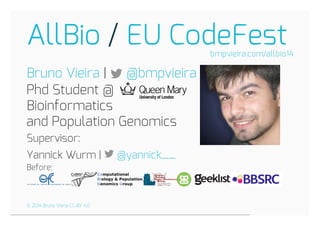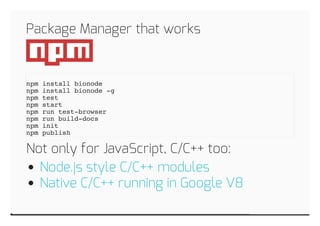AllBio and EU CodeFest 2014
- 1. AllBio EU CodeFest / | ? Phd Student @ Bioinformatics and Population Genomics Supervisor: Yannick Wurm | ? Before: bmpvieira.com/allbio14 Bruno Vieira @bmpvieira @yannick__ ? 2014 Bruno Vieira CC-BY 4.0
- 2. Some problems I faced during my research: Difficulty getting relevant descriptions and datasets from NCBI API using bio* libs For web projects, needed to implement the same functionality on browser and server Difficulty writing scalable, reproducible and complex bioinformatic pipelines
- 3. - Modular and universal bioinformatics Bionode.io Pipeable UNIX command line tools and JavaScript / Node.js APIs for bioinformatic analysis workflows on the server and browser. Collaborates with - Represent biological data on the web - Build data pipelines BioJS Dat Provides a streaming interface between every file format and data storage backend. "git for data" | ? | ? dat-data.com @maxogden @mafintosh
- 4. bionode.io (online shell) Examples BASH bionode-ncbi urls assembly Solenopsis invicta | grep genomic.fna http://ftp.ncbi.nlm.nih.gov/genomes/all/GCA_000188075.1_Si_gnG/ GCA_000188075.1_Si_gnG_genomic.fna.gz bionode-ncbi download sra arthropoda | bionode-sra bionode-ncbi download gff bacteria JavaScript var ncbi = require('bionode-ncbi') ncbi.urls('assembly', 'Solenopsis invicta'), gotData) function gotData(urls) { var genome = urls[0].genomic.fna download(genome) })
- 5. Difficulty getting relevant description and datasets from NCBI API using bio* libs Python example import xml.etree.ElementTree as ET from Bio import Entrez Entrez.email = "mail@bmpvieira.com" esearch_handle = Entrez.esearch(db="assembly", term="Achromyrmex") esearch_record = Entrez.read(esearch_handle) for id in esearch_record['IdList']: esummary_handle = Entrez.esummary(db="assembly", id=id) esummary_record = Entrez.read(esummary_handle) documentSummarySet = esummary_record['DocumentSummarySet'] document = documentSummarySet['DocumentSummary'][0] metadata_XML = document['Meta'].encode('utf-8') metadata = ET.fromstring('<root>' + metadata_XML + '</root>') for entry in Metadata[1]: print entry.text ftp://ftp.ncbi.nlm.nih.gov/genomes/all/GCA_000188075.1_Si_gnG Solution: bionode-ncbi
- 6. Need to reimplement the same code on browser and server. Solution: JavaScript everywhere Afra SequenceServer GeneValidator BioJS Biodalliance is converting parsers to Bionode
- 7. Difficulty writing scalable, reproducible and complex bioinformatic pipelines. Solution: Node.js Streams everywhere var ncbi = require('bionode-ncbi') var tool = require('tool-stream') var through = require('through2') var fork1 = through.obj() var fork2 = through.obj() ncbi .search('sra', 'Solenopsis invicta') .pipe(fork1) .pipe(dat.reads) fork1 .pipe(tool.extractProperty('expxml.Biosample.id')) .pipe(ncbi.search('biosample')) .pipe(dat.samples) fork1 .pipe(tool.extractProperty('uid')) .pipe(ncbi.link('sra', 'pubmed'))
- 8. Benefit from other JS projects Dat BioJS NoFlo
- 11. Reusable, small and tested modules
- 12. Some users and Contributors: Dat Biodalliance BioJS Yeo Lab (UC San Diego) Michael Lovci Olga Botvinnik Afra GeneValidator Soon: DNADigest
- 13. Thanks! Acknowledgements: ? ? ? ? ? ? @yannick__ @maxogden @mafintosh @alanmrice @dasmoth @biodevops
- 14. Why Node.js / JavaScript applies well to Bioinformatics Streams Easy to write CLI wrappers for Streams Reusable, small and tested modules Same language everywhere (JavaScript) Package Manager that works ( NPM ) Huge number modules ( 93327, 199/day ) Use other JS projects ( Dat , BioJS , NoFlo ) Possible to write Desktop GUI apps in JS
- 15. Module counts
- 16. Package Manager that works npm install bionode npm install bionode -g npm test npm start npm run test-browser npm run build-docs npm init npm publish Not only for JavaScript, C/C++ too: Node.js style C/C++ modules Native C/C++ running in Google V8




![bionode.io (online shell)
Examples
BASH
bionode-ncbi urls assembly Solenopsis invicta | grep genomic.fna
http://ftp.ncbi.nlm.nih.gov/genomes/all/GCA_000188075.1_Si_gnG/
GCA_000188075.1_Si_gnG_genomic.fna.gz
bionode-ncbi download sra arthropoda | bionode-sra
bionode-ncbi download gff bacteria
JavaScript
var ncbi = require('bionode-ncbi')
ncbi.urls('assembly', 'Solenopsis invicta'), gotData)
function gotData(urls) {
var genome = urls[0].genomic.fna
download(genome)
})](https://image.slidesharecdn.com/allbio14-140930211950-phpapp01/85/AllBio-and-EU-CodeFest-2014-4-320.jpg)
![Difficulty getting relevant description and
datasets from NCBI API using bio* libs
Python example
import xml.etree.ElementTree as ET
from Bio import Entrez
Entrez.email = "mail@bmpvieira.com"
esearch_handle = Entrez.esearch(db="assembly", term="Achromyrmex")
esearch_record = Entrez.read(esearch_handle)
for id in esearch_record['IdList']:
esummary_handle = Entrez.esummary(db="assembly", id=id)
esummary_record = Entrez.read(esummary_handle)
documentSummarySet = esummary_record['DocumentSummarySet']
document = documentSummarySet['DocumentSummary'][0]
metadata_XML = document['Meta'].encode('utf-8')
metadata = ET.fromstring('<root>' + metadata_XML + '</root>')
for entry in Metadata[1]:
print entry.text
ftp://ftp.ncbi.nlm.nih.gov/genomes/all/GCA_000188075.1_Si_gnG
Solution:
bionode-ncbi](https://image.slidesharecdn.com/allbio14-140930211950-phpapp01/85/AllBio-and-EU-CodeFest-2014-5-320.jpg)










